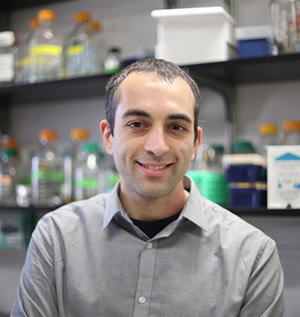By Kristin Koutmou
 Dr. Boris Zinshteyn always knew he would become a scientist. He immigrated to the United States at an early age, and his parents, who were trained as engineers in the Soviet Union, fostered his innate curiosity about how the world works. His formal scientific training began in high school, where he spent his afternoons working in the laboratory of Carmen Sapienza at Temple University studying unusual genetic imprinting events during mouse meiosis. Boris’ foray into RNA began as an undergraduate in the laboratory of Kazuko Nishikura at the Wistar Institute (at the University of Pennsylvania) where he investigated the contribution of A to I editing on microRNA-mediated gene silencing. Bitten by the RNA bug, Boris applied to graduate schools with strong RNA programs and carried out his graduate research with Professor Wendy Gilbert at MIT, where he applied transcriptome-wide sequencing technologies to study multiple aspects of eukaryotic translation. Boris is currently a Damon Runyon Post-doctoral Fellow at the Johns Hopkins School of Medicine where he studies mRNA decay in the laboratory of Professor Rachel Green.
Dr. Boris Zinshteyn always knew he would become a scientist. He immigrated to the United States at an early age, and his parents, who were trained as engineers in the Soviet Union, fostered his innate curiosity about how the world works. His formal scientific training began in high school, where he spent his afternoons working in the laboratory of Carmen Sapienza at Temple University studying unusual genetic imprinting events during mouse meiosis. Boris’ foray into RNA began as an undergraduate in the laboratory of Kazuko Nishikura at the Wistar Institute (at the University of Pennsylvania) where he investigated the contribution of A to I editing on microRNA-mediated gene silencing. Bitten by the RNA bug, Boris applied to graduate schools with strong RNA programs and carried out his graduate research with Professor Wendy Gilbert at MIT, where he applied transcriptome-wide sequencing technologies to study multiple aspects of eukaryotic translation. Boris is currently a Damon Runyon Post-doctoral Fellow at the Johns Hopkins School of Medicine where he studies mRNA decay in the laboratory of Professor Rachel Green.
Boris wants to uncover the mechanistic details of how fundamental cellular processes work. In his current project, he is developing genetic screens to identify new players in co-translational mRNA decay pathways. “I’m just getting to the exciting part where I have candidates to test and follow up”, he said. “In choosing post-doc training opportunities, I wanted to take some of the techniques I had learned and use them to zoom in on detailed mechanistic/biochemical questions. The Green lab is a place where biochemical dissection takes center stage, but also where these studies are increasingly augmented by the kinds of high-throughput assays that I learned in graduate school.”
“All trainees should get a basic proficiency in programming because it is the one skill that modern scientists need.”
Boris also minored in computer science as undergraduate—training which proved to be very helpful in his research. Given the recent explosion of sequencing technologies, he explained, “all trainees should get a basic proficiency in programming because it is the one skill that modern scientists need.” More generally, Boris believes that it is important “to be open to new possibilities and to be brave in science—and accept that sometimes you might have to change approaches or switch directions.” Finally, Boris emphasized the importance of reading the scientific literature both broadly and deeply to foster creativity.
Boris is an active member of the RNA Society, and has attended both the annual RNA Society meetings and the local RNA Salon on the Johns Hopkins campus. Boris enjoys the breadth of research presented at RNA Society meetings: “I think trainees should attend the annual meeting and take advantage of the opportunity to see work on less familiar topics, as well as to meet the people who are working in your area.” The annual meeting also provides a chance to learn about new methods people are developing, “even if the research is outside your current interests, many techniques end up being adaptable to all kinds of problems.”
Boris also commented that the annual RNA Society meeting is also a chance to meet and get to know potential mentors. He explained, “one year I came to the meeting with the intention of talking to potential post-doc advisors. I had talked to one PI at my poster and he offered me an interview. At the dance party later, we ended up having an impromptu dance-off!”
Boris’ favorite RNA molecule is tRNA. “The shape is so elegant. I keep a 3D model of one on my desk, next to a much smaller scale ribosome.” You can follow Boris on Twitter at @bzinsh, or contact him directly to learn more about exciting methods he is developing to study RNA decay.
